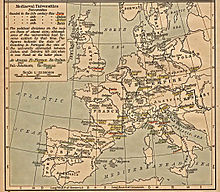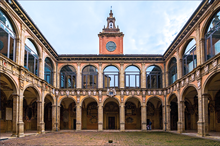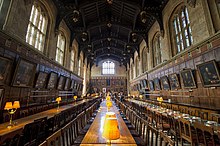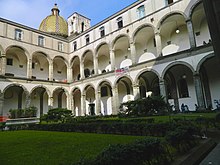
Back قائمة أقدم الجامعات المستمرة بالعمل في العالم Arabic Liste chronologique des universités européennes existant sans interruption French Daftar universitas tertua dalam operasi berkelanjutan ID





This is a list of the oldest existing universities in continuous operation in the world.
Inclusion in this list is determined by the date at which the educational institute first met the traditional definition of a university used by academic historians[Note 1][specify] although it may have existed as a different kind of institution before that time.[4] This definition limits the term "university" to institutions with distinctive structural and legal features that developed in Europe, and which make the university form different from other institutions of higher learning in the pre-modern world, even though these may sometimes now be referred to popularly as universities.
To be included in the list, the university must have been founded prior to 1500 in Europe or be the oldest university derived from the medieval European model in a country or region. It must also still be in operation, with institutional continuity retained throughout its history. So some early universities, including the University of Paris, founded around the beginning of the 13th century[5] but abolished by the French Revolution in 1793,[6] are excluded. Some institutions reemerge, but with new foundations, such as the modern University of Paris, which came into existence in 1896 after the Louis Liard law disbanded Napoleon's University of France system.
The word "university" is derived from the Latin universitas magistrorum et scholarium, which approximately means "community of teachers and scholars." The University of Bologna in Bologna, Italy, where teaching began around 1088 and which was organised into a university in the late 12th century, is the world's oldest university in continuous operation,[1] and the first university in the sense of a higher-learning and degree-awarding institute.[7][8][1] The origin of many medieval universities can be traced back to the Catholic cathedral schools or monastic schools, which appeared as early as the 6th century and were run for hundreds of years prior to their formal establishment as universities in the high medieval period.[9]
Ancient higher-learning institutions, such as those of ancient Greece, Africa, ancient Persia, ancient Rome, Byzantium, ancient China, ancient India and the Islamic world, are not included in this list owing to their cultural, historical, structural and legal differences from the medieval European university from which the modern university evolved.[Note 2][Note 3][12] These include the University of al-Qarawiyyin and Al-Azhar University, which were founded as mosques in 857 and 970 respectively and developed into madrasas prior to the establishment of any European university, making them the oldest institutions of higher learning in continuous operation in the world. They became universities in 1963 and 1961 respectively.
- ^ a b c de Ridder-Symoens, Hilde: A History of the University in Europe: Volume 1, Universities in the Middle Ages, Cambridge University Press, 1992, ISBN 0-521-36105-2, pp. 47–55
- ^ Storia d'Italia (in Italian). Vol. 4. Torino: UTET. 7 August 1981. p. 122. ISBN 88-02-03568-7.
- ^ Delle Donne, Fulvio (2010). Storia dello Studium di Napoli in età sveva (in Italian). Mario Adda Editore. pp. 9–10. ISBN 978-8880828419.
- ^ a b Hyde, J. K. (1991). "Universities and Cities in Medieval Italy". In Bender, Thomas (ed.). The University and the City: From Medieval Origins to the Present. Oxford: Oxford University Press. pp. 13–14. ISBN 978-0-19-506775-0.
- ^ Cite error: The named reference
Vergerwas invoked but never defined (see the help page). - ^ Jones, Colin (2006). "Queen of Cities". Paris : The Biography of a City. Paris: Penguin Books. p. 60. ISBN 978-0-14-303671-5.
- ^ Paul L. Gaston (2010). The Challenge of Bologna. Stylus. p. 18. ISBN 978-1-57922-366-3. Retrieved 25 December 2022.
- ^ Hunt Janin: "The university in medieval life, 1179–1499", McFarland, 2008, ISBN 0-7864-3462-7, p. 55f.
- ^ Riché, Pierre (1978). Education and Culture in the Barbarian West: From the Sixth through the Eighth Century. Columbia: University of South Carolina Press. pp. 126–127, 282–298. ISBN 978-0-87249-376-6.
- ^ Verger, Jacques: "Patterns", in: Ridder-Symoens, Hilde de (ed.): A History of the University in Europe. Vol. I: Universities in the Middle Ages, Cambridge University Press, 2003, ISBN 978-0-521-54113-8, pp. 35–76 (35):
- ^ Makdisi, George: "Madrasa and University in the Middle Ages", Studia Islamica, No. 32 (1970), pp. 255–264 (264):
- ^ Rüegg, Walter: "Foreword. The University as a European Institution", in: A History of the University in Europe. Vol. 1: Universities in the Middle Ages, Cambridge University Press, 1992, ISBN 0-521-36105-2, pp. XIX–XX.
Cite error: There are <ref group=Note> tags on this page, but the references will not show without a {{reflist|group=Note}} template (see the help page).
© MMXXIII Rich X Search. We shall prevail. All rights reserved. Rich X Search